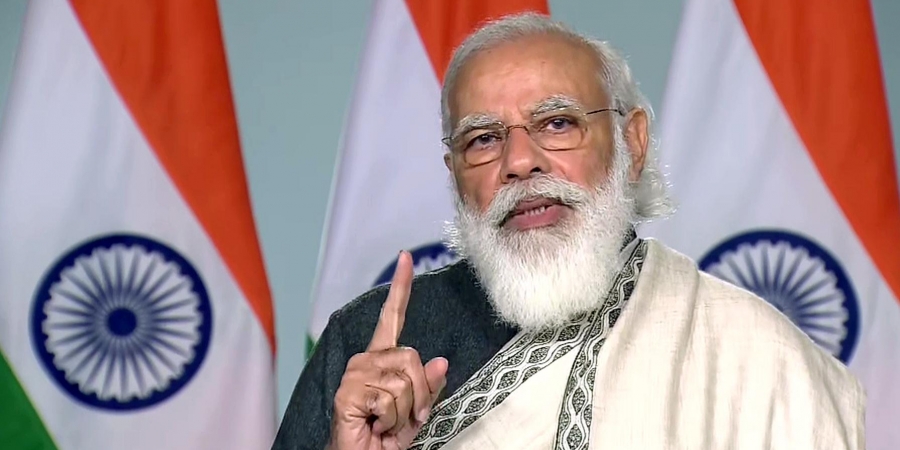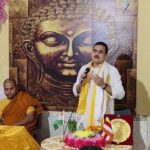Modi redirects our collective attention to Sri Aurobindo
- By : Anirban Ganguly
- Category : Articles

In his Mann Ki Baat on November 29, Prime Minister Modi made a profoundly inspiring reference to Sri Aurobindo. Movingly speaking of the Rishi, PM Modi said, ‘The more we read Sri Aurobindo, the greater is the insight that we get. The more my young friends learn about Sri Aurobindo, the greater will they learn about themselves, enriching themselves. The state of inner consciousness in which you are, where you are engaged in trying to achieve the many resolves, amid all this you will always find a new inspiration in Sri Aurobindo; you will find him showing you a new path!’ For those who have intensely read and engaged with Sri Aurobindo, this articulation and description can comprehend the preciseness of this observation.
Across the decades those who have been attracted to Sri Aurobindo’s vision and to his message have, in fact, concretely experienced this ever-renewing dimension, new inspiration and a new path each time one dives into the cosmic world of his thought and action. I cannot recollect when it was the last time that the Prime Minister of India, in a prime-time radio talk, spoke of Sri Aurobindo. The reference was not in the vein of a mere customary tribute, he urged instead the younger generations to read Sri Aurobindo, to internalise the myriad dimensions that he constantly radiates and to contextualise him continuously. As PM Modi himself indicated, there is a perennial aura to Sri Aurobindo; each generation, each movement, each crisis or opportunity finds some truth, some direction, some hint from his vast spiritual and intellectual corpus.
Modi re-oriented our collective focus to that reality. At a time when we are engaged in trying to re-discover our civilisational roots and inspiration for achieving national self-reliance, at a time when we are trying to recreate a new imagination for a new education for new India—an education that aims to generate a complex and vibrant scientific spirit, aspires to rekindle a deeper cultural and spiritual sense and to make that the foundation for India’s regeneration, and focuses on giving wide and comprehensive scope for an integral and many-sided self-expression—this tribute to Sri Aurobindo by the Prime Minister, who actually leads these multi-dimensional quest, is not only timely, but deeply symbolic as well. These aspirations that Sri Aurobindo had long spoken of, are also hopes which he called for being realised for our national life to be really free.
The quest for ‘Aatmanirbhar Bharat’ and the quest for a new approach to India’s education are movements that aim at fundamentally altering the economic, educational and intellectual dimension of India. In his unique manner, Modi has initiated these as societal movements, calling upon people at all levels and layers to actively participate and engage with these formulations. The vision of a self-reliant India and the vision of a new education for India, are the two aspects with which Sri Aurobindo had begun his public life and his revolutionary action. In fact, along with Lokmanya Tilak, Sri Aurobindo, in his brief political phase, had popularised the narrative of self-reliance and new education.
The Swadeshi industrial and art movement, the national education movement, which saw a mass response, were the foundations on which Sri Aurobindo argued the superstructure of freedom could be built and sustained. During his active political phase, at a time when the political narrative of self-reliance, self-help and Swadeshi was seeing ideational and political articulation, Sri Aurobindo spoke of “the attempt at self-development by self-help” as “absolutely necessary for our national salvation.” Arguing for “commercial and educational swarajya” in his speeches and writings of the period, Sri Aurobindo spoke of a Swadeshi which encourages “Indian labour, Indian manufacture, Indian articles, preferring our own goods by giving them a little stimulus…”
The only way the drain could be stopped, he wrote in his early political writings in the pages of the widely read Bande Mataram, was by establishing “a popular government which [could] be relied on to foster and protect Indian commerce and Indian industry conducted by Indian capital and employing Indian labour.” In his essays on national education, Sri Aurobindo spoke of perfecting and empowering all dimensions of the learner, and encouraging and nurturing a global outlook and appreciation, and yet be deeply rooted to the Adhyatmic—spiritual essence of India.
He inspiringly put it thus, “It must be an education that for the individual will make its one central object the growth of the soul and its powers and possibilities, for the nation will keep first in view the preservation, strengthening and enrichment of the nation-soul and its Dharma…” The New Education Policy thus reflects and embodies the essence, the core of Sri Aurobindo’s educational vision, it aims to realise Sri Aurobindo’s educational vision. Prime Minister Modi’s redirecting our collective attention to Sri Aurobindo; his exhortation to us to redirect our thoughts towards the light of the Sage’s message is a deep moment of awakening.

















